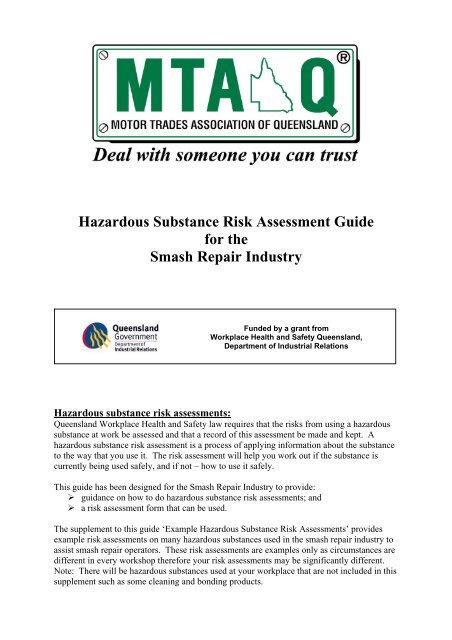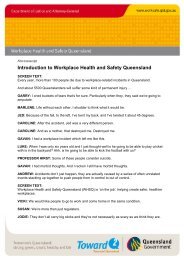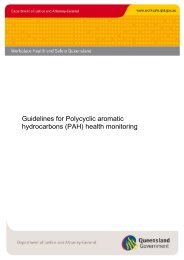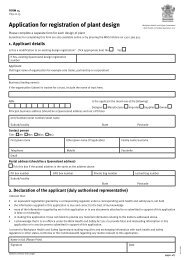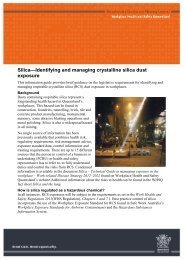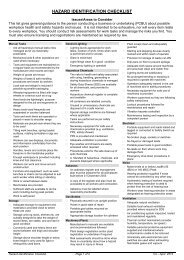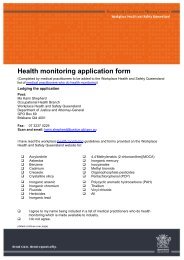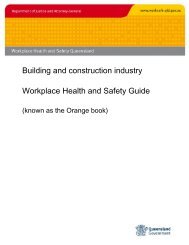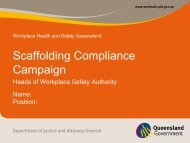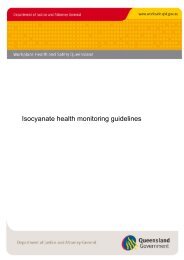MTAQ Hazardous substance risk assessment guide for the smash ...
MTAQ Hazardous substance risk assessment guide for the smash ...
MTAQ Hazardous substance risk assessment guide for the smash ...
You also want an ePaper? Increase the reach of your titles
YUMPU automatically turns print PDFs into web optimized ePapers that Google loves.
<strong>Hazardous</strong> Substance Risk Assessment Guide<strong>for</strong> <strong>the</strong>Smash Repair IndustryFunded by a grant fromWorkplace Health and Safety Queensland,Department of Industrial Relations<strong>Hazardous</strong> <strong>substance</strong> <strong>risk</strong> <strong>assessment</strong>s:Queensland Workplace Health and Safety law requires that <strong>the</strong> <strong>risk</strong>s from using a hazardous<strong>substance</strong> at work be assessed and that a record of this <strong>assessment</strong> be made and kept. Ahazardous <strong>substance</strong> <strong>risk</strong> <strong>assessment</strong> is a process of applying in<strong>for</strong>mation about <strong>the</strong> <strong>substance</strong>to <strong>the</strong> way that you use it. The <strong>risk</strong> <strong>assessment</strong> will help you work out if <strong>the</strong> <strong>substance</strong> iscurrently being used safely, and if not – how to use it safely.This <strong>guide</strong> has been designed <strong>for</strong> <strong>the</strong> Smash Repair Industry to provide:‣ guidance on how to do hazardous <strong>substance</strong> <strong>risk</strong> <strong>assessment</strong>s; and‣ a <strong>risk</strong> <strong>assessment</strong> <strong>for</strong>m that can be used.The supplement to this <strong>guide</strong> ‘Example <strong>Hazardous</strong> Substance Risk Assessments’ providesexample <strong>risk</strong> <strong>assessment</strong>s on many hazardous <strong>substance</strong>s used in <strong>the</strong> <strong>smash</strong> repair industry toassist <strong>smash</strong> repair operators. These <strong>risk</strong> <strong>assessment</strong>s are examples only as circumstances aredifferent in every workshop <strong>the</strong>re<strong>for</strong>e your <strong>risk</strong> <strong>assessment</strong>s may be significantly different.Note: There will be hazardous <strong>substance</strong>s used at your workplace that are not included in thissupplement such as some cleaning and bonding products.
When to do a hazardous <strong>substance</strong> <strong>risk</strong> <strong>assessment</strong>:• Now, if it has not yet been done.• For a new hazardous <strong>substance</strong>: be<strong>for</strong>e using <strong>the</strong> <strong>substance</strong> or as soon as practicableafter <strong>the</strong> <strong>substance</strong> is first used;• For a hazardous <strong>substance</strong> already in use: no more than 5 years after <strong>the</strong> last <strong>risk</strong><strong>assessment</strong> was done <strong>for</strong> that <strong>substance</strong>; or• When:o The way <strong>the</strong> <strong>substance</strong> is used changes significantly;o New in<strong>for</strong>mation about <strong>the</strong> <strong>substance</strong> is available;o Health surveillance or monitoring shows <strong>the</strong> control measures are inadequate;o Control measures are changedBe<strong>for</strong>e doing your hazardous <strong>substance</strong> <strong>risk</strong> <strong>assessment</strong>s:Be<strong>for</strong>e starting on your hazardous <strong>substance</strong> <strong>risk</strong> <strong>assessment</strong>s, you will need a current (lessthan 5 years old) Material Safety Data Sheet (MSDS <strong>for</strong> short) <strong>for</strong> each hazardous<strong>substance</strong> used at your workplace. Ask your suppliers <strong>for</strong> <strong>the</strong>se if you do not have <strong>the</strong>malready.Look at each MSDS <strong>for</strong> a statement about whe<strong>the</strong>r <strong>the</strong> <strong>substance</strong> is hazardous or nothazardous – <strong>for</strong> example look <strong>for</strong> wording like “<strong>Hazardous</strong> according to <strong>the</strong> criteria ofNOHSC”. If <strong>the</strong> <strong>substance</strong> is not classified as ‘<strong>Hazardous</strong>’, it can still have effects on healthand <strong>the</strong> obligation of making sure people’s health and safety are protected still applies. You<strong>the</strong>re<strong>for</strong>e still need to assess and control <strong>the</strong> <strong>risk</strong>s. The same process as <strong>for</strong> a hazardous<strong>substance</strong> <strong>risk</strong> <strong>assessment</strong> could be applied to do this.Most <strong>smash</strong> repair businesses use hundreds of hazardous <strong>substance</strong>s (numerous differentcolours of tinters, types of thinners / reducers etc. etc. etc.). It is possible to group <strong>substance</strong>sthat are similar in <strong>the</strong>ir ingredients and uses <strong>the</strong>reby per<strong>for</strong>ming one <strong>risk</strong> <strong>assessment</strong> to coverlots of similar <strong>substance</strong>s.In doing this, it is essential to carefully check <strong>the</strong> MSDSs <strong>for</strong> significant differences to makesure all potential exposures and ingredients are catered <strong>for</strong>. It may also be necessary to domultiple <strong>risk</strong> <strong>assessment</strong>s <strong>for</strong> <strong>the</strong> one <strong>substance</strong> if it is used in different ways – mixing <strong>the</strong><strong>substance</strong> may need to be a different <strong>risk</strong> <strong>assessment</strong> to using <strong>the</strong> <strong>substance</strong> if <strong>the</strong> exposuresare different (such as mixing spray paint as opposed to spray painting – <strong>the</strong> exposures aredifferent).In <strong>the</strong> supplement <strong>for</strong> this <strong>guide</strong>, many <strong>substance</strong>s commonly used in <strong>smash</strong> repair havebeen put into groups. There will still be many at your workplace that won’t fit <strong>the</strong>se groupsthus needing fur<strong>the</strong>r <strong>risk</strong> <strong>assessment</strong>s to be done. This list will however cover <strong>the</strong> majority ofhazardous <strong>substance</strong>s used in <strong>the</strong> <strong>smash</strong> repair industry. The groups are:• Spray painting ‘Category 1’ paint systems (Higher <strong>risk</strong> paints such as 2 pack paints -base, solid and clear coats with thinners/reducers etc)• Spray painting category 2 paint systems (paints such as single pack / enamel paintswith thinners etc.)• Mixing Category 1 and Category 2 paint systems• Mixing and applying body fillers• Sanding body fillers• Using sealers• Using degreasers• Using cutting and buffing compounds
In addition, individual <strong>risk</strong> <strong>assessment</strong>s have been done on:• Using wax and grease remover• Using gun wash• Using window cleaner• Using alloy wheel cleaner• Using rust removerNote <strong>for</strong> this <strong>guide</strong> and its supplement: ‘Category 1 paint system’ means: Higher <strong>risk</strong> paintsmixed with thinners / reducers / hardeners etc. These paint systems pose a higher <strong>risk</strong>because <strong>the</strong>y can cause cancer, poisoning, sensitisation of <strong>the</strong> respiratory system (asthma), orcontain mutagens (causes mutations) or teratogens (causes birth mal<strong>for</strong>mations). Thiscategory includes 2 pack paints containing isocyanates and o<strong>the</strong>r paints if <strong>the</strong>y containBenzene, Cadmium, Chromium or Lead.‘Category 2 paint system’ means: Paint systems that do not contain <strong>the</strong> <strong>substance</strong>s that makepaints category 1 (Isocyanates, Benzene, Cadmium, Chromium, Lead) but still pose a high<strong>risk</strong>. These paint systems are generally single pack or enamel paint systems (mixed withthinners) etc. They contain organic solvents and are usually class 3 dangerous goods.How to do a hazardous <strong>substance</strong> <strong>risk</strong> <strong>assessment</strong>:Using <strong>the</strong> <strong>risk</strong> <strong>assessment</strong> <strong>for</strong>m (see appendix A) is one way of keeping a suitable hazardous<strong>substance</strong> <strong>risk</strong> <strong>assessment</strong> record, however you can make your own record if you prefer (referto <strong>the</strong> Workplace Health and Safety Regulation 1997 <strong>for</strong> what has to be in <strong>the</strong> record and <strong>for</strong>fur<strong>the</strong>r details). The following guidance is to assist in completing <strong>the</strong> provided <strong>for</strong>m.Each number relates to <strong>the</strong> question number on <strong>the</strong> <strong>risk</strong> <strong>assessment</strong> <strong>for</strong>m.1. Name of <strong>substance</strong>.Write <strong>the</strong> name of <strong>the</strong> <strong>substance</strong> or <strong>substance</strong>s if it is a mixture. If it is a group of <strong>substance</strong>s,write <strong>the</strong> group name here and refer to an attachment where each <strong>substance</strong>’s name is listed.If you are doing more than one <strong>risk</strong> <strong>assessment</strong> <strong>for</strong> <strong>the</strong> one <strong>substance</strong> (perhaps one <strong>for</strong> mixingit and one <strong>for</strong> using it) – you can include this in <strong>the</strong> name of <strong>substance</strong>. For example, “Mixingcategory one paints – refer to attached list <strong>for</strong> details” and <strong>the</strong> attachment must list everypaint / thinner / reducer / hardener this <strong>risk</strong> <strong>assessment</strong> applies to.2. How is <strong>the</strong> <strong>substance</strong> used?Briefly write how <strong>the</strong> <strong>substance</strong> or group of <strong>substance</strong>s is used. For example “<strong>the</strong> mixedpaint, hardener and thinners are spray painted onto cars”.Note: A <strong>risk</strong> <strong>assessment</strong> cannot be done from behind a desk – you must observe what youremployees actually do.3. How are people exposed to <strong>the</strong> <strong>substance</strong>?There are four ways (routes of exposure) a hazardous <strong>substance</strong> can get into a person:• Skin - ei<strong>the</strong>r affects <strong>the</strong> skin directly or is absorbed through <strong>the</strong> skin and affects o<strong>the</strong>rparts of <strong>the</strong> body:o Splashed straight onto <strong>the</strong> skin or onto clo<strong>the</strong>s <strong>the</strong>n soaks through to <strong>the</strong> skin;o Vapours / mists / fumes / dusts etc. in <strong>the</strong> air that come into contact with skin.• Eyes – same as <strong>for</strong> skin – splashes, vapours / fumes / mists / dust etc. affect <strong>the</strong> eyesdirectly or can be absorbed through <strong>the</strong>m.• Inhalation – <strong>the</strong> most problematic – vapours / mists / fumes / dusts etc. are brea<strong>the</strong>d inand ei<strong>the</strong>r do damage where <strong>the</strong>y hit a surface in <strong>the</strong> respiratory system or areabsorbed by <strong>the</strong> body and cause health problems.• Ingestion – <strong>the</strong> least common type of exposure – swallowing <strong>substance</strong>s.
Refer to <strong>the</strong> MSDS and think about how <strong>the</strong> <strong>substance</strong> is used at your workplace. Tick ormark one or more of <strong>the</strong>se routes of exposure – add notes if you need to.4. How much of <strong>the</strong> <strong>substance</strong> are workers exposed to during <strong>the</strong> task?Are <strong>the</strong>y using a few millilitres/grams or several litres/kilograms?5. For how long are workers exposed to <strong>the</strong> <strong>substance</strong>?Do <strong>the</strong>y use it every day <strong>for</strong> most of <strong>the</strong> day (eg: 5 hours per day, 6 days a week) or onlyoccasionally (eg: once a month <strong>for</strong> about ½ hour).6. Briefly, what are <strong>the</strong> health effects of exposure to this <strong>substance</strong>?Read through <strong>the</strong> MSDS – in particular <strong>the</strong> Health Hazard In<strong>for</strong>mation section – summarise<strong>the</strong> relevant in<strong>for</strong>mation from <strong>the</strong> MSDS on your <strong>risk</strong> <strong>assessment</strong>.7. What engineering control measures are recommended by <strong>the</strong> MSDS and/or label?Once again, refer to <strong>the</strong> MSDS, in particular <strong>the</strong> Precautions <strong>for</strong> Use section. Summarise <strong>the</strong>relevant in<strong>for</strong>mation on your <strong>risk</strong> <strong>assessment</strong>.8. Currently, what engineering control measures are used at your workplace to controlexposure to <strong>the</strong> <strong>substance</strong>?Engineering control measures are those that are a physical change to <strong>the</strong> work or machinery orworkplace <strong>for</strong> example: ventilation systems (spray booths, extraction systems etc); isolationwith barriers etc. Note: think about whe<strong>the</strong>r this is <strong>the</strong> same or better than what <strong>the</strong> MSDSrecommends.9. If engineering controls are used, are <strong>the</strong>y maintained and checked <strong>for</strong> effectiveness?For example: checking air flow rates, servicing and maintaining <strong>the</strong> spray booth.10. What personal protective equipment (PPE) is recommended by <strong>the</strong> MSDS and/orlabel?From <strong>the</strong> MSDS – Precautions <strong>for</strong> use section and <strong>the</strong> label of <strong>the</strong> <strong>substance</strong>.Note: Be specific (<strong>for</strong> example “respirator and gloves” is not enough in<strong>for</strong>mation -specifywhat type of respirator and gloves such as “½ face respirator with organic solvent filters andNitrile Rubber gloves”). The MSDS sometimes doesn’t provide specific in<strong>for</strong>mation – call<strong>the</strong> supplier of <strong>the</strong> product if you need fur<strong>the</strong>r details.11. Currently, what PPE is actually used?Summarise what PPE employees currently use. Note: think about whe<strong>the</strong>r this is <strong>the</strong> same orbetter than what <strong>the</strong> MSDS recommends.12. Are any o<strong>the</strong>r control measures recommended by <strong>the</strong> MSDS and/or label?O<strong>the</strong>r controls might include:• Rotation of staff (to minimise <strong>the</strong> length of exposure to each individual employee);• Using <strong>the</strong> <strong>substance</strong> out of hours to decrease how many people will be exposed;• Writing procedures on how to do <strong>the</strong> task;Training and supervision of employees (employees using hazardous <strong>substance</strong>s must betrained).
13. Are any o<strong>the</strong>r control measures currently used at <strong>the</strong> workplace?Summarise any o<strong>the</strong>r controls that are already in place but have not been written downanywhere else on this <strong>risk</strong> <strong>assessment</strong>.14. What is <strong>the</strong> level of <strong>risk</strong> from use of this hazardous <strong>substance</strong>?Look at your answers in questions 4, 5 and 6 to work out how dangerous <strong>the</strong> <strong>substance</strong> is toyour workers. Then, compare your answers from questions 8, 9, 11 and 13 with what <strong>the</strong>MSDS recommends (questions 7, 10 and 12) to work out if exposure to <strong>the</strong> <strong>substance</strong>s isbeing controlled enough to make your employees safe.Note: These options refer to whe<strong>the</strong>r <strong>the</strong> <strong>risk</strong> is significant or not significant. “Significant<strong>risk</strong>” means that <strong>the</strong> work with a <strong>substance</strong> is likely to cause health problems.For example, <strong>the</strong>re would be a "significant <strong>risk</strong>" if:• <strong>the</strong> severity of <strong>the</strong> possible health effects from exposure to <strong>the</strong> <strong>substance</strong> aresubstantial; or• <strong>the</strong>re are no control measures in place or <strong>the</strong>y are not adequate to protect people from<strong>the</strong> <strong>substance</strong>; or• people are exposed to a large amount of <strong>the</strong> hazardous <strong>substance</strong> - i.e. <strong>the</strong> worker isexposed to a large amount or <strong>for</strong> a long time each day.You can now choose one of <strong>the</strong> four following options which apply <strong>for</strong> your workplace basedon <strong>the</strong> level of <strong>risk</strong> from use of <strong>the</strong> hazardous <strong>substance</strong>:1. Risks not significant and not likely to increase in <strong>the</strong> future• Choose this option if it is unlikely that <strong>the</strong> use of <strong>the</strong> <strong>substance</strong> will impact onsomeone’s health and <strong>the</strong> <strong>risk</strong> is not likely to increase in <strong>the</strong> future.• For example:o <strong>the</strong> amounts or rate of use of <strong>the</strong> <strong>substance</strong> are too small to be a <strong>risk</strong>,even if <strong>the</strong> controls failo <strong>the</strong> use of <strong>the</strong> <strong>substance</strong> obviously and strictly con<strong>for</strong>ms to <strong>the</strong>in<strong>for</strong>mation in both <strong>the</strong> MSDS and labelo similar <strong>assessment</strong>s in <strong>the</strong> past found <strong>the</strong> <strong>risk</strong>s were not significant, andwork conditions are still <strong>the</strong> same2. Risks are significant but are effectively controlled (but could increase in <strong>the</strong>future)The <strong>risk</strong> of most uses of hazardous <strong>substance</strong>s is significant and you must control <strong>the</strong>exposure effectively. This option is <strong>the</strong>re<strong>for</strong>e <strong>the</strong> one you should be achieving <strong>for</strong>most of your hazardous <strong>substance</strong> <strong>risk</strong> <strong>assessment</strong>s.• Risks, while controlled effectively at <strong>the</strong> moment could increase in <strong>the</strong> future if<strong>for</strong> example:o control measures are not used / maintained properly or are faultyo human erroro <strong>the</strong> amount of <strong>the</strong> <strong>substance</strong> used increases3. Risks are significant and not effectively controlled• Choose this option if <strong>the</strong> use of a hazardous <strong>substance</strong> is likely to cause healthproblems because exposure to it is not being effectively controlled – <strong>for</strong>example:o <strong>the</strong>re are complaints of headaches, irritation, excessive odour (or o<strong>the</strong>rhealth effects)
o <strong>the</strong> <strong>substance</strong> gets splashedo control measures are not adequate to protect people from <strong>the</strong> <strong>substance</strong>o safe work practices are not being followed• If <strong>risk</strong>s are significant and not effectively controlled you may need to havesome monitoring done so you can figure out how much and what type of extracontrols need to be put into place.4. Uncertain about <strong>the</strong> <strong>risk</strong>s• Choose this option if you cannot accurately estimate how much people areexposed to or if <strong>the</strong>re is not enough in<strong>for</strong>mation about <strong>the</strong> <strong>substance</strong>.• If you are uncertain about <strong>the</strong> <strong>risk</strong>s, consider having air monitoring done tohelp you find how much people are being exposed to. Also try to get morein<strong>for</strong>mation about <strong>the</strong> <strong>substance</strong> (or if you can’t get in<strong>for</strong>mation, use a different<strong>substance</strong> that you can get in<strong>for</strong>mation <strong>for</strong>). Then do a new <strong>risk</strong> <strong>assessment</strong>.15. Does air monitoring need to be done?You may need to have air monitoring done if you don’t know:• how much employees are exposed to, or• if <strong>the</strong> control measures in place are enough to protect <strong>the</strong>ir health and safetyIf you choose to do monitoring, you can seek advice and assistance from a workplace healthand safety consultant who has skills and qualifications in occupational hygiene.16. What control measures will be implemented?Compare <strong>the</strong> relevant control measures recommended in <strong>the</strong> MSDS with those used at yourworkplace. Are <strong>the</strong> controls used at your workplace adequate to make sure employees’ healthand safety is protected? Consider your control measure options by working through <strong>the</strong>hierarchy of controls (as set out in <strong>the</strong> Workplace Health and Safety Act 1995) – starting at<strong>the</strong> top with “elimination” and working down to “personal protective equipment (PPE)”:Note: The higher level control measures in <strong>the</strong> hierarchy of controls (elimination, substitution<strong>the</strong>n engineering control measures) reduce <strong>the</strong> hazard at its source and <strong>the</strong>re<strong>for</strong>e are moreeffective than <strong>the</strong> lower level control measures (administrative control measures and personalprotective equipment), which just protect people from <strong>the</strong> hazard. Elimination:If a hazardous <strong>substance</strong> isn’t <strong>the</strong>re it can’t harm people. So if you can do without it, getrid of it. Substitution:Chemical manufacturers are frequently developing new products that are less harmful butdo <strong>the</strong> same job. Or <strong>the</strong>re may be alternative processes that use less harmful chemicals. Engineer out <strong>the</strong> hazard by isolation:For example, use of an automatic gun wash machine eliminates <strong>the</strong> need <strong>for</strong> workers to doit by hand. Engineer out <strong>the</strong> hazard by ventilation:You might be able to remove vapours and fumes from <strong>the</strong> workplace through an exhaustventilation system or by increasing <strong>the</strong> flow of fresh air into <strong>the</strong> area.
IMPORTANT: Don’t rely on being able to smell a chemical to know if people arebreathing it in. Some chemicals have no, or very little, odour. Administrative controls:Can you minimise exposure through (<strong>for</strong> example):o Rotation of staff (to minimise <strong>the</strong> length of exposure to each individualemployee);o Using <strong>the</strong> <strong>substance</strong> after hours (so fewer people are exposed);o Writing procedures on how to do <strong>the</strong> task;o Training and supervision of employees. Personal Protective Equipment (PPE)Is personal protective equipment and clothing needed to protect <strong>the</strong> employee from <strong>the</strong><strong>substance</strong>? (this is <strong>the</strong> least effective way to control exposure)Note: People using personal protective equipment have to be trained in how to use andmaintain <strong>the</strong> equipment properly. Types of PPE include:o Eye protection such as goggles or safety glasseso Skin protection such as gloves, coveralls, shoeso Respiratory protective equipment (respirator / air supplied hood)Note: Normally a combination of two or more types of control measures will be necessary toachieve adequate protection.17. Is health surveillance required?You must arrange and pay <strong>for</strong> health surveillance <strong>for</strong> your employee if:• They have had an adverse reaction or illness due to exposure to a hazardous <strong>substance</strong>at work and <strong>the</strong>re is a way of doing health surveillance <strong>for</strong> it; or• The level of <strong>risk</strong> (from question 14) is “significant” and <strong>the</strong> <strong>substance</strong> is or containsone of <strong>the</strong> <strong>substance</strong>s shown below (refer to <strong>the</strong> ingredients list on <strong>the</strong> MSDS):• 4,4’ Methylenebis (2-chloroaniline) (MOCA)• Acrylonitrile• Asbestos• Benzene• Cadmium• Creosote• Crystalline silica• Inorganic arsenic• Inorganic chromium• Isocyanates• Organophosphatepesticides• Pentachlorophenol(PCP)• Polycyclic aromatichydrocarbons (PAH)• Thallium• Vinyl chloride18. Date:Date <strong>the</strong> <strong>risk</strong> <strong>assessment</strong> is done.19. Review date:Risk <strong>assessment</strong>s have to be reviewed at least every five years (or sooner if <strong>the</strong>re is a changein <strong>the</strong> <strong>substance</strong> or <strong>the</strong> way it is used).20. Person(s) conducting <strong>risk</strong> <strong>assessment</strong>:The names of <strong>the</strong> persons who conducted <strong>the</strong> <strong>risk</strong> <strong>assessment</strong>.
Risk <strong>assessment</strong> attachments:You can attach in<strong>for</strong>mation to your <strong>risk</strong> <strong>assessment</strong>s such as lists of <strong>substance</strong>s on that <strong>risk</strong><strong>assessment</strong>; or any o<strong>the</strong>r details that are important.Where to from here?• Put <strong>the</strong> material safety data sheets somewhere your employees can easily access <strong>the</strong>m;and• Put into place <strong>the</strong> control measures (decided on in <strong>the</strong> <strong>risk</strong> <strong>assessment</strong>) that will make useof <strong>the</strong> product safe; and• Train <strong>the</strong> people who will be using those products how to use <strong>the</strong>m safely; and• Supervise <strong>the</strong>m to make sure <strong>the</strong>y are doing what <strong>the</strong>y should be doing.For full details of Queensland workplace health and safety hazardous<strong>substance</strong> laws:Refer to <strong>the</strong> legislation:• Queensland Workplace Health and Safety Act 1995;• Queensland Workplace Health and Safety Regulation 1997;• (Workplace Health and Safety Queensland) <strong>Hazardous</strong> Substances Code of Practice2003.Disclaimer: Any advice given to you as an obligation holder by <strong>MTAQ</strong> is given only to assist you to discharge your obligations under <strong>the</strong>Workplace Health and Safety Act 1995 (Qld). Compliance with this advice does not relieve you of your obligations under that Act. Any advice isgiven on <strong>the</strong> basis that you will make your own independent <strong>assessment</strong> of what action is necessary to ensure your compliance with <strong>the</strong> Act. The<strong>risk</strong> <strong>assessment</strong>s provided are examples only – your <strong>risk</strong> <strong>assessment</strong>s will need to cater <strong>for</strong> specific hazardous <strong>substance</strong>s and circumstances inyour business.Whilst all care will be taken in providing advice to you, <strong>MTAQ</strong> and its staff will not be liable <strong>for</strong> any errors or omissions or <strong>for</strong> any loss or damagesuffered by you or any person which arises (directly or indirectly) from your reliance on this advice or <strong>for</strong> any breach by you of your obligationsunder <strong>the</strong> Act.
Appendix A:Risk <strong>assessment</strong> <strong>for</strong>m(You can use this <strong>for</strong>m or make up your own)
Business name:<strong>Hazardous</strong> Substances Risk AssessmentThe chemical’s label and Material Safety Data Sheet (MSDS) will be needed to complete <strong>the</strong> <strong>risk</strong> <strong>assessment</strong>.References: Workplace Health and Safety Regulation Part 13; <strong>the</strong> <strong>Hazardous</strong> Substances Code of Practice 20031. Name of Substance: _______________________________________________________(or name of <strong>the</strong> task and <strong>substance</strong>s if appropriate)2. How is <strong>the</strong> <strong>substance</strong> used? - i.e. describe <strong>the</strong>task? (If <strong>the</strong> chemical is used <strong>for</strong> a number of differenttasks a <strong>risk</strong> <strong>assessment</strong> may be needed <strong>for</strong> each task).3. How are people exposed to <strong>the</strong> <strong>substance</strong>? (Tick ormark applicable routes or entry)4. How much of <strong>the</strong> <strong>substance</strong> are workers exposedto during <strong>the</strong> task? (eg: in litres / millilitres,kilograms/grams)Skin (splashed onto or absorbed through):Eyes (splashed onto or absorbed through):Inhalation (brea<strong>the</strong>d in):Ingestion (swallowed):5. For how long are workers exposed to <strong>the</strong><strong>substance</strong>? (How often is <strong>the</strong> chemical used. eg: inhours per day and days per week)6. Briefly, what are <strong>the</strong> health effects of exposure tothis <strong>substance</strong>? (Refer to <strong>the</strong> MSDS)Skin:Eyes:Inhalation:Ingestion andchronic:7. What engineering control measures (eg:extraction ventilation; dilution ventilation) arerecommended by <strong>the</strong> MSDS and/or label?8. Currently, what engineering controls are used tocontrol exposure to <strong>the</strong> <strong>substance</strong>?9. If engineering controls are used, are <strong>the</strong>ymaintained and checked <strong>for</strong> effectiveness? (GiveDetails)10. What Personal Protective Equipment (PPE) isrecommended by <strong>the</strong> MSDS and/or label?11. Currently, what PPE is used? (Give Details)Skin:Eyes:Inhalation:Skin:Eyes:Inhalation:
12. Are any o<strong>the</strong>r control measures (eg: procedures,rotation of people, using <strong>substance</strong> after hours tominimise how many people are exposed…)recommended by <strong>the</strong> MSDS and/or label?13. Are any o<strong>the</strong>r control measures currently usedat <strong>the</strong> workplace?14. What is <strong>the</strong> level of <strong>risk</strong> from use of thishazardous <strong>substance</strong> (select one)?1. Risks not significant and not likely to increase in <strong>the</strong>future2. Risks are significant but effectively controlled (butcould increase in <strong>the</strong> future)3. Risks are significant and not effectively controlled4. Uncertain about <strong>the</strong> <strong>risk</strong>s (Conduct air monitoringand/or health surveillance [see below] or obtain fur<strong>the</strong>rin<strong>for</strong>mation and advice)15. Does air monitoring need to be done?You can have air monitoring done to:• find out how much your employees are being exposed to• find out if <strong>the</strong> controls being used are adequate to ensureemployee’s health and safety is protected16. What control measures will be implemented?(The best type of control is by elimination; howevero<strong>the</strong>r types of controls can be used).Hierarchy of Control Measures Elimination (MOST EFFECTIVE) Substitution (with a less hazardous <strong>substance</strong>) Engineer out <strong>the</strong> hazard by isolation Engineer out <strong>the</strong> hazard by ventilation Administrative controls (rotation, procedures etc) Personal Protective Equipment (LEAST EFFECTIVE)17. Is health surveillance required?Health surveillance is required if:• Someone has an adverse effect from a hazardous<strong>substance</strong> at work and <strong>the</strong>re is a way to detect signs of <strong>the</strong>health effect; or:• The level of <strong>risk</strong> (from question 14) is significant and <strong>the</strong><strong>substance</strong> contains (or is) one or more of <strong>the</strong> following:• 4,4’ Methylenebis(2-chloroaniline)(MOCA)• Acrylonitrile• Asbestos• Benzene• Cadmium• Creosote• Crystalline silica• Inorganic arsenic• Inorganic chromium• Isocyanates• Organophosphatepesticides• Pentachlorophenol(PCP)• Polycyclic aromatichydrocarbons(PAH)• Thallium• Vinyl chloride(Refer to section 109 of <strong>the</strong> Queensland Workplace Health and Safety Regulation 1997)Level of <strong>risk</strong>: ………..Explanation of why this <strong>risk</strong> level is chosen:Give details (if any):18. Date: 19. Review Date:20. Person/s conducting <strong>risk</strong> <strong>assessment</strong>:Disclaimer: Any advice given to you as an obligation holder by <strong>MTAQ</strong> is given only to assist you to discharge your obligations under <strong>the</strong> Workplace Health and SafetyAct 1995 (Qld). Compliance with this advice does not relieve you of your obligations under that Act. Any advice is given on <strong>the</strong> basis that you will make your ownindependent <strong>assessment</strong> of what action is necessary to ensure your compliance with <strong>the</strong> Act. The example <strong>risk</strong> <strong>assessment</strong>s provided may need to be altered to cater<strong>for</strong> specific hazardous <strong>substance</strong>s and circumstances in your business.Whilst all care will be taken in providing advice to you, <strong>MTAQ</strong> and its staff will not be liable <strong>for</strong> any errors or omissions or <strong>for</strong> any loss or damage suffered by you or anyperson which arises (directly or indirectly) from your reliance on this advice or <strong>for</strong> any breach by you of your obligations under <strong>the</strong> Act.
<strong>Hazardous</strong> <strong>substance</strong> <strong>risk</strong> <strong>assessment</strong> attachment:list of <strong>substance</strong>s on this <strong>risk</strong> <strong>assessment</strong>Risk <strong>assessment</strong> name:Substance’s name: Brand name: Date of MSDS
Substance’s name (cont.): Brand name (cont): Date of MSDS (cont)


